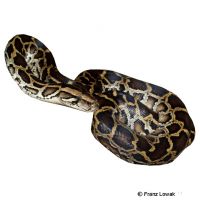Indian Rock Python (Python molurus)
| Indian Rock Python Python molurus | |
|---|---|
| Name | Indian Rock Python |
| Name Lat. | Python molurus |
| Family | Pythons |
| Family lat. | Pythonidae |
| Order | Scaled Reptiles |
| Order lat. | Squamata |
| Origin | South Asia |
| Habitat | Forests, grassland |
| Diet | Small mammals, birds |
| Humidity | 70-90 % |
| Behavior | Nocturnal, peaceful |
| Keeping | Individual, pair, group |
| Care Level | Experts only |
| Reproduction | Oviparous |
| Housing | Semi-humid terrarium |
| Life Span | 25-30 years |
| Protection | CITES Appendix II; EU Annex B |
| Metric Units | |
| Size | 300 cm |
| Temperature | 24-30 °C |
| Temperature Local | 35 °C |
| Housing Size | 250 x 150 x 150 cm |
| US Units | |
| Size | 118" |
| Temperature | 75-86 °F |
| Temperature Local | 95 °F |
| Housing Size | 100" x 60" x 60" |
Distribution and habitat
The range of the mainly ground-dwelling, crepuscular to nocturnal pale tiger pythons extends from southeast Pakistan through India and Sri Lanka to Nepal, Bhutan and Bangladesh. They live in open forests as well as scrubland and grassland, always near bodies of water.
Maintenance
Minimum dimensions for the terrarium, according to the size and number of animals:
| 1-2 animals | 0,75KL x 0,5KL x 0,5KL (L x W x H) |
Body length (KL) is measured on the largest animal. For each additional animal the floor space should be increased by 20%. A terrarium of e.g. L 250 x W 150 x H 150 cm is recommended, which should be placed in a quiet and vibration-free place
They need a terrarium structured with large roots, sturdy climbing branches, bamboo sticks and stones (hiding places and visual protection) with a moisture-retaining substrate, e.g. of peat-earth mixture with foliage, a moist shelter as well as a large, easy-to-clean water basin (approx. 1/4 of the floor area) for bathing. Much of the substrate should be kept slightly moist at all times. Several times a day the inside of the terrarium should be finely sprayed with water (humidity), but a rain or mist system is better.
| Temp. day: 24-30 °C | Temp. night: 20-24 °C | Temp. local: up to 35 °C | Humidity: 70-90 |
Thermostatically controlled floor heating is recommended. Lighting duration must be 12-14 hrs. depending on the season. Daylight fluorescent tubes are ideal.
Diet
According to their size, they feed on guinea pigs, rabbits and other mammals, as well as pigeons, chickens and quails. After acclimation, they often succeed in switching to dead food animals. Juveniles should be offered food every 8-10 days and adults every 14-20 days, with occasional periods of fasting (e.g., skipping a feeding). If the snake is disturbed after feeding, this may result in vomiting of the prey. Generally, it is better to offer several small feeders, rather than one large one. If it does not eat for a long period of time, both the timing and the food should be varied. It is important to fortify the food animals with vitamins and minerals. Since the snake could be injured by live rodents, it should not be left unattended with them.
Reproduction and breeding
Probing by the veterinarian is the only reliable method of sex determination. The female lays up to 100 eggs in a warm, moist trough. The clutch is incubated for 55-85 days, at about 30 °C. The female can keep the temperature constant by muscle contraction. The 40-60 cm large young can be fed with small mice after a few days
The life expectancy can be 20-25 years bgetragen.
Species protection
The animal population must be reported to the competent authority in writing immediately after the start of keeping. Your pet store will be happy to provide you with further information.
Species protection: WA Appendix I; EU Appendix A. You will receive a CITES document with the purchase, which confirms that this animal is an offspring. Please keep the CITES document in a safe place!
Important
Animals with a length over 3 m are rare
If the air temperature in the terrarium is lower than the temperature in the water tank, there is a risk of respiratory infection
When handling, always have snake hooks, protective gloves and cold water ready and have several people available to assist
The terrarium must have good ventilation without drafts and meet the species specific needs. Measuring devices, such as thermometers, hygrometers, etc., are necessary. The lighting has to correspond to the species-specific day-night rhythm and has to be placed in such a way that the animals cannot injure themselves. The terrarium should be locked in such a way that neither unauthorized persons can open it nor the animals can escape. Contamination must be removed regularly
Further literature can be found in your pet store.
References
Text: Christian Sänger; Image: Franz Lowak
Source: BMELV (1997): Tierschutzgutachten - Mindestanforderung an die Haltung von Reptilien; ENGELMANN (2006): Zootierhaltung - Tiere in menschlicher Obhut: Reptilien und Amphibien, Harri Deutsch Verlag
- Gemäß § 21 Abs. 5 Tierschutzgesetz idgF
